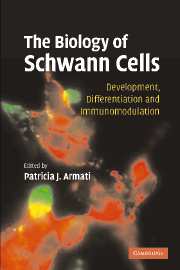Book contents
- Frontmatter
- Contents
- Preface
- Contributors
- 1 Introduction to the Schwann cell
- 2 Early events in Schwann cell development
- 3 The molecular organisation of myelinating Schwann cells
- 4 The role of the extracellular matrix in Schwann cell development and myelination
- 5 The biology of perisynaptic (terminal) Schwann cells
- 6 Cytokine and chemokine interactions with Schwann cells: the neuroimmunology of Schwann cells
- 7 Schwann cells as immunomodulatory cells
- 8 Mutations in Schwann cell genes causing inherited neuropathies
- 9 Guillain–Barré syndrome and the Schwann cell
- 10 Chronic idiopathic demyelinating polyneuropathy and Schwann cells
- References
- Index
- Plate section
1 - Introduction to the Schwann cell
Published online by Cambridge University Press: 13 August 2009
- Frontmatter
- Contents
- Preface
- Contributors
- 1 Introduction to the Schwann cell
- 2 Early events in Schwann cell development
- 3 The molecular organisation of myelinating Schwann cells
- 4 The role of the extracellular matrix in Schwann cell development and myelination
- 5 The biology of perisynaptic (terminal) Schwann cells
- 6 Cytokine and chemokine interactions with Schwann cells: the neuroimmunology of Schwann cells
- 7 Schwann cells as immunomodulatory cells
- 8 Mutations in Schwann cell genes causing inherited neuropathies
- 9 Guillain–Barré syndrome and the Schwann cell
- 10 Chronic idiopathic demyelinating polyneuropathy and Schwann cells
- References
- Index
- Plate section
Summary
THEODOR SCHWANN 1810–1882
The Schwann cell is named in honour of the German physiologist Theodor Schwann (1810–1882, Figure 1.1) who is now acknowledged as the founder of modern histology. In addition to describing the Schwann cell, he made numerous contributions to the fields of biology, physiology and histology – not least as one of the instigators and main advocates of cell theory. The cell theory defined the cell as the base unit of all living organisms, and had great influence on the study of both plants and animals. The cell theory was radical for the time and irrevocably discredited Vitalism, the mainstream belief that life was attributed to a vital force. Among other things, Schwann is known for recognising that the crystals seen during fermentation, first reported by Leeuwenhoek in 1680, were in fact living organisms; although it was not until Pasteur in 1878 wrote to Schwann acknowledging this observation that Schwann's finding was accepted. In fact, Pasteur's germ theory stems from Schwann's work in which he showed that microorganisms were required for the putrefaction of meat.
Schwann spent his undergraduate years at the University of Bonn and then the equivalent of postgraduate study in Wuerzburg and Berlin. Schwann was appointed Professor of Anatomy at Louvain in 1839. In 1848 he moved to the Chair of Anatomy in Liege. In a biography of Schwann (Causey 1960), Causey reported that he avoided the strife of scientific controversy and appears to have risen above petty jealousies.
- Type
- Chapter
- Information
- The Biology of Schwann CellsDevelopment, Differentiation and Immunomodulation, pp. 1 - 12Publisher: Cambridge University PressPrint publication year: 2007
- 4
- Cited by



